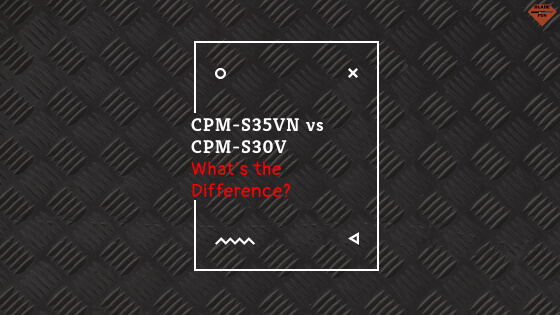S35VN (also called CPM-S35VN) and S30V (also called CPM-S30V) are both some of the most popular steels used in knife making. They’re actually pretty similar, as well. In fact, they both have the same carbon and chromium content, and from tests, appear to perform about the same. So, what’s the difference?
While both are premium steels, S35VN has slightly more toughness and can get a finer edge than S30V. S35VN has more niobium, which leads to finer carbides, increasing toughness and allowing it to get a finer edge. It’s unlikely you’ll notice much of a difference, but on paper, S35VN is better.
If you’d like to learn a bit more about this (and potentially nerd out about it), then let’s dive in a bit further.
How S35VN and S30V Are Made
S35VN and S30V are both made through the same process: The CPM, or Crucible Particle Metal, process designed by Crucible Industries, a New York-based steel manufacturer. It basically makes the steel homogeneous by evenly distributing the carbides (steel components, essentially) throughout the steel.
Both the metals came from a collaboration between Chris Reeve, a (pretty famous) knife maker. Both of the metals were made specifically for the knife industry–which is a pretty remarkable event. Almost every other steel out there used for blade steels were originally designed for another purpose.
Differences Between S35VN and S30V
Both S35VN and S30V are going to pretty much function the same. You’re unlikely to find much of a difference between the two in performance tests.
Under a microscope, though, you will find a difference: The carbides in S35VN are finer, which leads to more consistency in the steel, more toughness, and easier sharpening. The finer carbides also mean you can get a finer edge on S35VN.
S30V, on the other hand, can be slightly harder to sharpen and gets a toothier edge than S35VN. Because of the larger particles and less consistency, S30V can also sometimes be prone to chipping.
Chemically, the two steels also show differences. S30V has about 1.45% carbon, 14% chromium, 4% vanadium, and 2% molybdenum.
S35VN is basically the upgraded version of S30V, having about 1.4% carbon, 14% chromium, 3% vanadium, 2% molybdenum, and 0.5% niobium.
Each of the components do different things: Carbon is for strength, chromium is for corrosion resistance, vanadium is for strength and wear resistance, molybdenum increases hardenability (basically meaning that it’s going to be more consistently tough), and niobium is like vanadium, only with finer particles.
Because niobium is finer than vanadium, it leads to more consistency in the blade, more toughness, easier sharpening, and the ability to get a finer edge on the knife–all things that S35VN has over S30V.
S30V
S30V was released at the end of 2001 as a high-end steel. It’s still considered a premium steel, and one of the best all-around steels you’ll be able to get for a knife.
It’s like the jack of all trades for knife steel: It’s a well-balanced steel when it comes to the different properties it exhibits. It’s hard to go wrong with S30V.
S35VN
S35VN is like the upgraded version of S30V, released in 2009. As I’ve explained, it’s slightly better than S30V on paper, but in practice, it’s unlikely you’ll be able to notice much of a difference.
If S30V is the jack of all trades, S35VN would be its older brother, Jim: S35VN is the Jim of all trades (yes, I know that doesn’t exactly equate to the “jack of all trades” saying).
Basically, in practice, they’re pretty much identical, but on paper (and to more steel-savvy knife owners), S35VN is better than S30V.

